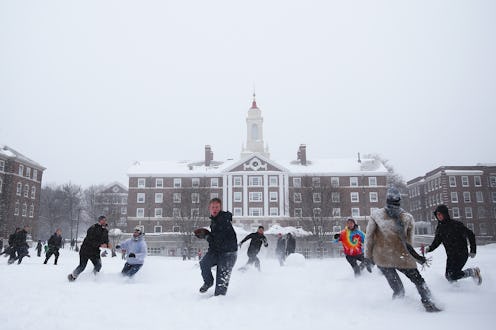News
Some Foreign Students Are Avoiding The U.S. & It's Almost Certainly Trump's Fault

Studying abroad is on the rise. More students around the world are taking advantage of multicultural learning. But there's a top destination that is suffering from lower enrollment, the United States. Americans continue to study elsewhere at higher rates according to a new study by the Institute of International Education, but fall 2017 international enrollments in the United States are down by 7 percent.
The executive summary, preliminary data, and media reports point to several different reasons, but the current political climate in the country likely has something to do with it. The preliminary report results doesn't mention Trump at all, and other, positive data from 2016 is presented first (the U.S. Department of State Bureau of Educational and Cultural Affairs is involved in the creation of the report). But there are thoughts out there about this administration's impact.
Rajika Bhandari, head of research for the Institute of International Education, acknowledged the travel ban may have something to do with it when speaking to The New York Times. "Concerns around the travel ban had a lot to do with concerns around personal safety based on a few incidents involving international students, and a generalized concern about whether they’re safe," Bhandari told The Times.
That was not the only negative news story this past year that could affect foreign parents and students' decision to attend school elsewhere. Two Indian engineers were shot in a Kansas bar in February, and one of them died. Trump didn't address the issue for six days. Also white supremacist alt right rallies would not make the country as appealing for any non-white foreign student.
One bit of data would also suggest that there are some areas of the country, or at least certain colleges, that are more appealing to foreign students than others. Some 45 percent of campuses saw a decrease in foreign enrollments, but 31 percent increased increases this fall. And 24 percent reported no change, the preliminary Open Doors report data read. They're focused in large, diverse states with top colleges like California, New York, Texas, Massachusetts, and Illinois. The top states all saw an increase this year.
A decrease could affect the economy in the country, particularly in areas where universities play an outsize role. The Department of Commerce estimates that international students accounted for $39 billion in spending in the country in 2016 to pay for things like tuition, room, and board.
One thing important to note is that Trump is not solely the cause of the decrease, because last year saw new enrollments go down by about 3 percent. That was the first decrease in 12 years since the report was first written. IIE's Bhandari spoke at a press conference Monday morning that was broadcast live on the group's Facebook. She said a range of factors play into the decrease in 2017. Among them are competition from other English-speaking countries' universities, concerns around visa processing delays, and also concerns about the continuing rising costs of U.S. tuition.
In the report's preliminary findings, President and CEO Allan E. Goodman of IIE called on U.S. schools to work to keep the numbers up. “Students continue to be attracted to the high quality and diverse opportunities offered by U.S. colleges and universities," Goodman said. "But it is critical for U.S. institutions to set strategic goals and be proactive in reaching out to students and families in a wide range of countries in the coming year, and for the United States to keep its academic doors open to students from all over the world.”
The one positive news from 2016 is that more foreign students are staying in the United States after they finish their degrees to continue learning through internship programs called “optional practical training." Thanks to that program, a record 1.08 million international students were enrolled in United States institutions of higher learning in 2016.